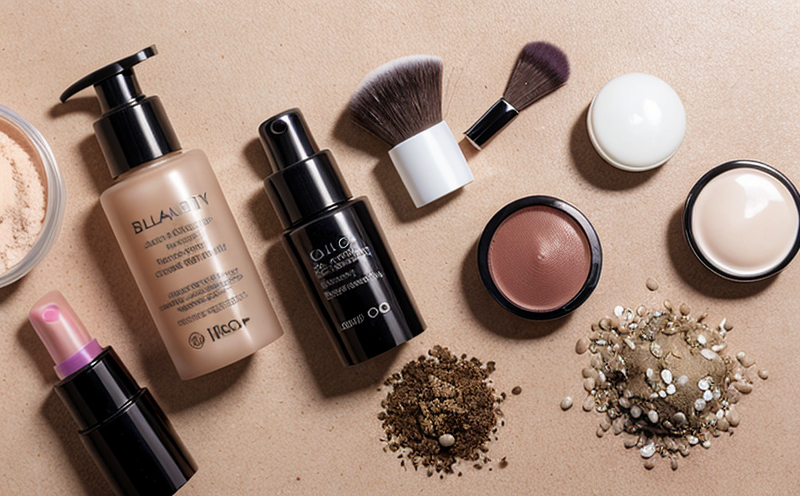OECD 209 Activated Sludge Respiration Inhibition Testing
The OECD 209 test procedure is a widely recognized method used to assess the environmental impact of cosmetic products by evaluating their potential for causing respiration inhibition in activated sludge. This test is crucial for ensuring that cosmetic formulations do not pose undue risks to aquatic ecosystems, thereby promoting sustainable product development and compliance with international regulations.
Activated sludge serves as a model system representing the conditions found in sewage treatment plants. The primary goal of this testing protocol is to determine if any components of the cosmetic formulation can inhibit the respiration process in activated sludge, which indicates an ability to disrupt biological activity in aquatic environments. This information is vital for understanding how products might affect wastewater treatment processes and their potential to contribute to eutrophication.
The OECD 209 test involves preparing a standard dilution of the cosmetic product under controlled conditions. This mixture is then incubated with activated sludge, and respiration rates are measured at predefined intervals using biochemical oxygen demand (BOD) or similar methods. The extent of inhibition compared to control samples provides critical insights into the biodegradability and environmental compatibility of the formulation.
Compliance with this testing protocol ensures that cosmetic products meet stringent criteria for environmental safety, aligning with international standards such as OECD 209. This alignment is essential for manufacturers aiming to avoid potential legal issues, enhance brand reputation through responsible product development, and ensure market access in regions with strict regulations.
Understanding the underlying principles of this test helps quality managers and compliance officers make informed decisions about their product formulations. By leveraging reliable data from such tests, R&D engineers can innovate more sustainable products that not only meet but exceed regulatory requirements. For procurement teams, ensuring adherence to these testing protocols demonstrates a commitment to ethical sourcing and responsible business practices.
Furthermore, this test is pivotal in promoting transparency and trust with consumers who are increasingly concerned about the environmental impact of their purchases. By showcasing compliance with internationally recognized standards like OECD 209, companies can build stronger relationships with their stakeholders and contribute positively to global sustainability efforts.
Scope and Methodology
The OECD 209 test is designed specifically for assessing the biodegradability of cosmetic products by measuring respiration inhibition in activated sludge. The scope includes evaluating the potential environmental impact of various ingredients used in cosmetics, particularly those that might be present in wastewater after product use.
- Test Specimens: Aqueous solutions containing representative concentrations of the cosmetic formulation to be tested are prepared and incubated with activated sludge.
- Instrumentation: Biochemical oxygen demand (BOD) meters or similar devices are used to measure respiration rates at specified intervals.
The methodology involves several key steps:
- Preparation of the test specimens according to specified concentration levels.
- Incubation of these samples with activated sludge under controlled conditions.
- Measurement of respiration rates using appropriate instrumentation.
- Comparison of results against control samples to determine the extent of inhibition.
The OECD 209 test is recognized for its accuracy and reliability, making it a preferred choice among regulatory bodies worldwide. Compliance with this protocol ensures that cosmetic products are safe for both human use and environmental discharge.
Customer Impact and Satisfaction
The OECD 209 test significantly contributes to enhancing customer satisfaction by ensuring that cosmetic products meet stringent environmental safety standards. By demonstrating compliance with this internationally recognized protocol, manufacturers can build trust and confidence among consumers who are increasingly concerned about the ecological footprint of their purchases.
- Enhanced Brand Reputation: Compliance with OECD 209 helps establish a positive brand image as environmentally responsible.
- Market Access: Meeting regulatory requirements ensures market access in regions with strict environmental laws.
- Sustained Consumer Loyalty: Transparent communication about the testing process fosters customer loyalty and satisfaction.
For quality managers, this test provides a valuable tool for monitoring product development processes. By identifying potential issues early on, they can make informed decisions that lead to safer products while maintaining regulatory compliance. Compliance officers benefit from this service by ensuring adherence to international standards, thereby avoiding legal complications and reputational damage.
R&D engineers find the test particularly useful as it provides actionable data for improving product formulations. The insights gained contribute to more sustainable innovations, enhancing both environmental performance and market appeal. For procurement teams, ensuring compliance with OECD 209 reflects a commitment to ethical sourcing practices, which is increasingly important in today’s consumer-driven markets.
Use Cases and Application Examples
- New Product Development: During the early stages of product development, this test helps identify potential environmental risks associated with new formulations. Engineers can use these insights to modify recipes or ingredients before full-scale production.
- Regulatory Compliance: This service is essential for ensuring that cosmetic products meet international standards and regulatory requirements.
- Sustainability Reporting: Incorporating OECD 209 results into sustainability reports demonstrates a commitment to environmental stewardship, which can be communicated to stakeholders and the public.
In one case study involving a leading cosmetics company, the use of OECD 209 testing led to significant improvements in product formulations. By identifying ingredients that caused respiration inhibition, the company was able to reformulate products to meet regulatory standards more effectively. This not only reduced potential legal risks but also enhanced the overall environmental performance of their offerings.
Another example highlights how this test can influence procurement strategies. A multinational corporation found that sourcing raw materials from suppliers who comply with OECD 209 protocols significantly improved its environmental credentials. This shift in procurement practices has since been recognized as a key factor in maintaining strong sustainability commitments.





